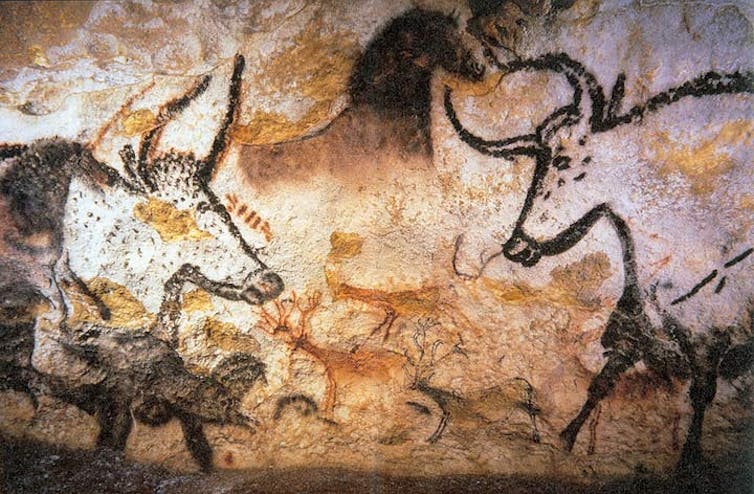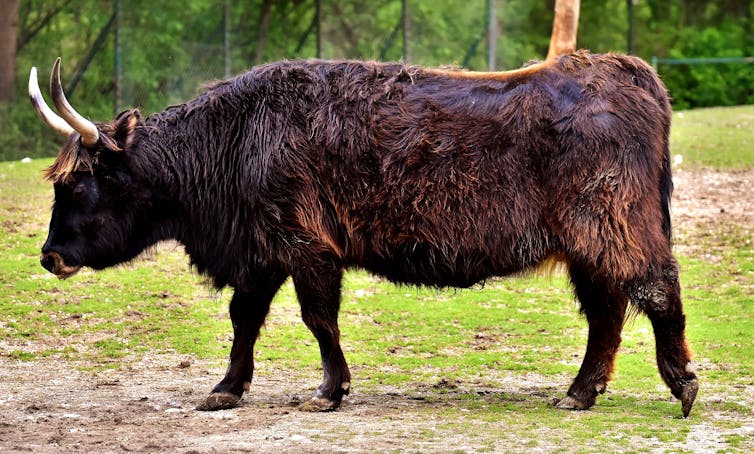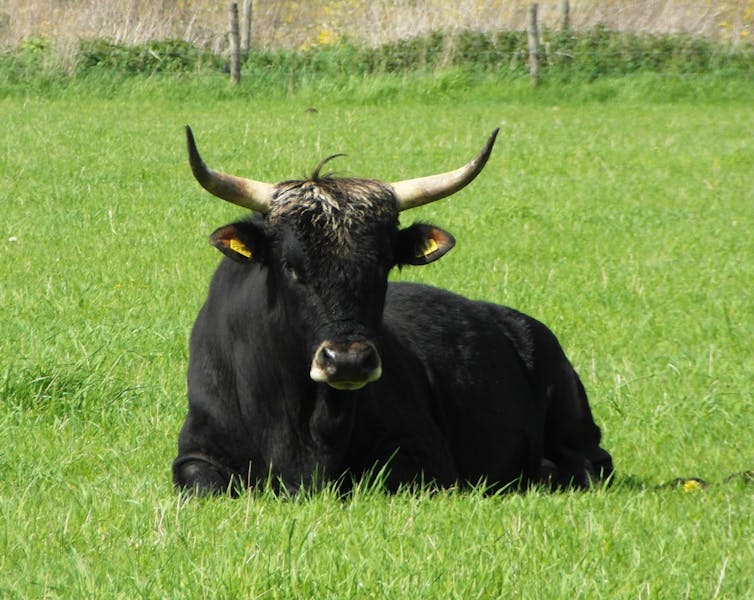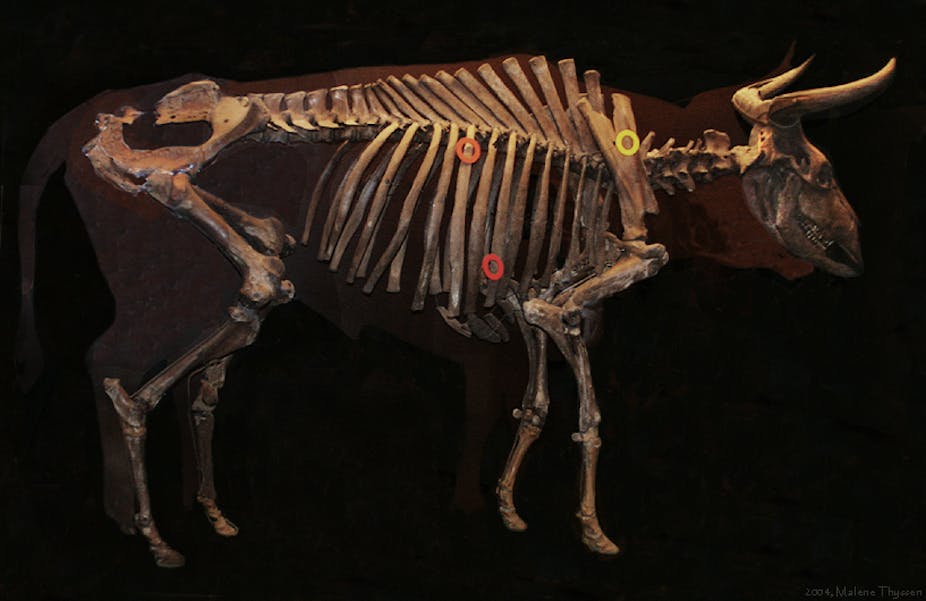Rewilding and restoration of land often rely on the reintroduction of species. But what happens when what you want to reintroduce no longer exists? What if the animal in question is not only locally extinct, but gone for good?
Yes, this might sound like the plot of Jurassic Park. But in real life this is actually happening in the case of the Aurochs (Bos primigenius). This wild ancestor of all modern cattle has not been seen since the last individual died in 1627, in today’s Poland.
Aurochs have been deep within the human psyche for as long as there have been humans, as attested by their prominence in cave art. However, the advent of agriculture and domestication put the magnificent animal on a path to extinction.
So why bring the Aurochs back today and how? And what is the likely outcome?
What is left of Aurochs, besides their depiction in cave paintings, are some fossil remains and some descriptions in the historical record. “Their strength and speed are extraordinary,” wrote the Roman emperor, Julius Caesar, in Commentarii de bello Gallico.
Despite the former large range of habitat of this animal (from the Fertile Crescent to the Iberian Peninsula, from Scandinavia to the Indian subcontinent), the historical record is quite slim on exact descriptions. And in all likelihood its size, behaviour, and general temperament will have varied across different environments. Despite this likely variation, the Auroch has survived into modernity as the primordial, powerful and enormous, ox.

A super-bull
The idea around today is that the Aurochs’ characteristics have survived, genetically scattered throughout its descendants. By breeding these together and selecting offspring that show increasingly more Aurochs-like traits, the theory is that we can eventually re-create something very similar to the lost animal. This theory is known as back-breeding: literally breeding backwards.
The first attempt to revive the Aurochs was made in the 1930s in Germany by two zoo directors, the brothers Lutz and Heinz Heck, with an undeniable Nazi party affiliation.
Their creation, now known as the Heck cattle, took only 12 years to accomplish and mixed breeds of domestic cattle with fighting bulls from Spain. The brothers focused more on size and aggression than on being faithful to the anatomical description of the Aurochs. This is partly why nobody today considers Heck cattle to be actual recreations of an extinct species, something reflected in the name these animals carry.
The Heck cattle made it through World War II and have since populated pastures and zoos throughout Europe. Though certainly not Aurochs, many find that they do the Aurochs’ job just fine. This is why the famous Oostvaardersplassen nature reserve in the Netherlands uses them as one of their primary grazers.
Recreating wilderness
For most of the 20th century it was assumed that the landscape in Europe before human settlement was mostly forest. Frans Vera, a Dutch biologist, changed this inherited wisdom and proposed that the primeval European landscape was a mosaic consisting of forest as well as meadows and other kinds of habitat. One of the main reasons for this, he argued, is that big animals (the Aurochs among them) would have engineered this landscape through their grazing behaviour, something now known as “natural grazing”.
The Oostvaardersplassen, founded by Vera, is his way of proving that he is right. The herds of Heck cattle were introduced to engineer the landscape, to see what happens to the land in the presence of many grazers.
The theory of natural grazing has attracted many that are eager to introduce grazing animals to new land, in the hope that they will become the engineers of a future European wilderness. This push for wild grazing animals is one of the primary factors behind the drive to recreate the Aurochs.

As the world is urbanising, rural land is being abandoned. In Europe, it is predicted that farmland abandonment will continue apace through the middle of the century.
This changing land-use pattern across continental scales has re-energised the restoration debate. The Vera hypothesis of an original mozaic landscape is motivating others to restore and rewild by using big grazers.
What an Aurochs should look like
Since the Heck brothers conducted their hasty experiments there have been new attempts at back-breeding. Heck cattle have also become an element of this new experimentation.
There are currently projects to recreate the Aurochs in several European countries. One of the largest attempts is led by the Taurus Foundation in partnership with Rewilding Europe, a rewilding organisation that wants to introduce the new Aurochs across the continent, as ecosystem engineers. Rival projects exist in the Netherlands, Germany and Hungary, and the Heck cattle are not going anywhere.
There is no shared set of criteria that guides everyone towards the same goal. One of the obvious criteria is genetic, but it was only in 2015 that Stephen Park and his colleagues were able to sequence the first full Aurochs genome. The genetic material came from one single fossilised specimen, and much work is still to be done to understand the genetic variability of the extinct species.

It is unlikely that an organisation will be able to impose a standard for what, in the future, will count as an Auroch.
Some argue that bringing extinct species back has no ethical basis and is in fact impossible, while others consider it an ethical duty to do so. The likeliest result of current and past experimentation is a future full of competing Aurochs, with new genetic paths leading into an unknown future.
Functionally speaking, it makes little difference what the created animals look like, as long as they behave a certain way. But part of the drive for recreating a lost animal is undoubtedly aesthetic: people want the new to look like their idea of the old. And this, more than anything, will ensure future rivalries between competing back-breeders. In the drive to bring one species back, we are almost certain to create several.


